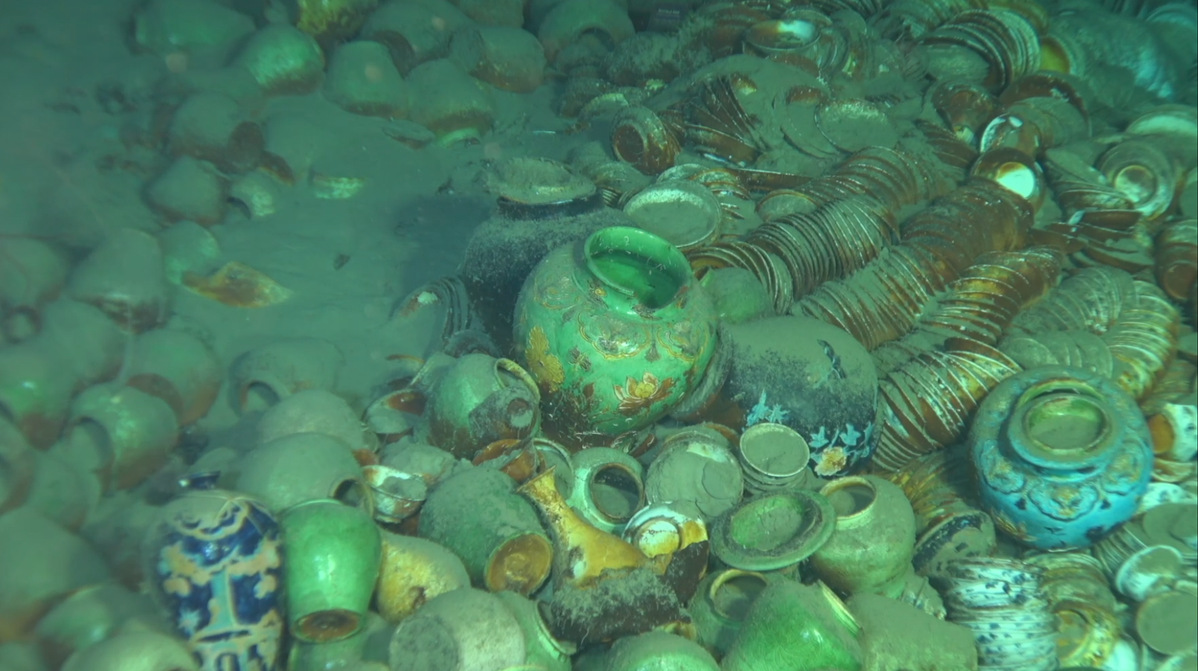Shipwrecks filled with relics found undersea


Relics: Findings to provide clues of trade route changes
Two ancient shipwrecks, probably dating back to the middle of the Ming Dynasty (1368-1644), have been found at a depth of 1,500 meters in the South China Sea, the National Cultural Heritage Administration announced on Sunday in the coastal city of Sanya, Hainan province.
A scientific research team from the Chinese Academy of Sciences' Institute of Deep-sea Science and Engineering discovered the shipwrecks on a continental slope in October. It was the first time that China had found such an expansive ancient shipwreck site so deep under the sea.
The shipwrecks have been named by researchers as "Northwest Continental Slope No 1 and No 2 Shipwrecks in the South China Sea".
According to Yan Yalin, director of the National Cultural Heritage Administration's archaeology department, preliminary investigation showed that relics from the No 1 shipwreck were scattered over an area of around 10,000 square meters.
It is estimated that more than 100,000 cultural relics — mainly porcelain items — are lying concealed on the spot, as most of the ship is still buried in sand, and some of its exposed parts are buried by up to 3 meters of relics.
On board the No 2 shipwreck, which is about 20 kilometers from the No 1 shipwreck, several processed logs of wood were found, along with a small number of ceramic items.
Based on the study of some porcelain relics that were salvaged from the site, the No 1 shipwreck probably dates back to the reign of Emperor Zhengde (1506-21) and the No 2 to the reign of Emperor Hongzhi (1488-1505).
"The well-preserved relics are of high historical, scientific and artistic value. It may be a world-class archaeological discovery in the deep sea," Yan said.
"The findings are key evidence of the ancient Maritime Silk Road, and a major breakthrough for historical study in Chinese overseas trade, navigation and porcelain (products)," he added.
Items from Jingdezhen, Jiangxi province, and the Longquan Kiln in present-day Zhejiang province — both key porcelain production and export hubs in ancient China — dominated the relics discovered near the No 1 shipwreck.
According to a video clip made public by the research team on Sunday, a wide variety of items including blue-and-white porcelain, pieces of celadon pottery and green glazed ceramic wares were found on the site.
Archaeologists said that the logs found on the No 2 shipwreck indicate the nature of import trade at the time, as timber has been recorded as an imported item in ancient Chinese documents.
Tang Wei, director of the National Centre for Archaeology, said the new discoveries will provide key references for understanding the historical changes in trade routes across the South China Sea.
"Discovery of inbound and outbound ancient ships in the same area demonstrates the significance of the route. It helps us study the Maritime Silk Road's reciprocal flow," Tang said.

The first round of investigation into the two ancient shipwrecks was officially launched on Saturday and will continue through June.
The exact coordinates of the shipwrecks have not been released in order to protect the relics, but a metal surveying marker was set on the seabed on Saturday near the No 1 shipwreck to facilitate future research, Yan said.
The research is being conducted by about 30 experts from the National Centre for Archaeology, the Institute of Deep-sea Science and Engineering, and the China (Hainan) Museum of the South China Sea.
China's scientific research vessel Tansuo 1, equipped with the submersible Shenhai Yongshi, or Deep Sea Warrior, took researchers underwater for the exploration on Saturday. Chen Chuanxu, a scientist at the Institute of Deep-sea Science and Engineering, said that another vessel, the Tansuo 2, equipped with the submersible Fendouzhe, or Striver, will join the mission.
Advanced technological approaches, including soft robotics inspired by bionics and material science, were employed during the operation to salvage some of the relics from the shipwreck sites. New methods of scanning, photography and monitoring were also used.
"Speaking of protection and real-time monitoring of such a large underwater site at a depth of 1,500 meters, we have no precedent in the world," Chen said, adding that the researchers are currently trying to remotely monitor the site.
Between now and April 2024, the submersibles are projected to conduct around 50 dives, according to Song Jianzhong, a researcher at the National Centre for Archaeology. "We first need to figure out the condition of the shipwrecks, and then we can draft plans for archaeological excavation and conservation," Song said.
He added that future expeditions will also cover geophysical and geological studies and research of marine life.
China's underwater archaeology previously focused mainly on the shallow sea and areas close to islands and reefs. The situation began to change in 2018, when the National Centre for Archaeology and the Institute of Deep-sea Science and Engineering jointly established a laboratory for deep-water archaeology.
In 2022, the joint team found cultural relics, including coins ranging all the way from the Tang Dynasty (618-907) to the Qing Dynasty (1644-1911), at a depth of about 2,100 meters near the Xisha Islands.
"China will promote international cooperation in protecting underwater cultural relics and share its experiences," Yan said.
- Taiwan separatist forces are heading for a 'dead end', expert says
- A suspect involved in kidnapping and murdering Chinese citizens extradited to China
- Shandong connects 1,000 MW offshore solar project to the grid
- Top political advisor meets Chinese Buddhist delegates
- People's Liberation Army encircles Taiwan in drills
- 38th Snow Sculpture Art Expo opens trial run in Harbin





































